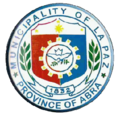La Paz | |
|---|---|
| Municipality of La Paz | |
 Map of Abra with La Paz highlighted | |
 Interactive map of La Paz | |
Location within the Philippines | |
| Coordinates: 17°40′26″N120°41′05″E / 17.6739°N 120.6847°E | |
| Country | Philippines |
| Region | Cordillera Administrative Region |
| Province | Abra |
| District | Lone district |
| Barangays | 12 (see Barangays) |
| Government | |
| • Type | Sangguniang Bayan |
| • Mayor | Danielle Belyne B. Bernos |
| • Vice Mayor | Julbert B. Timbreza |
| • Representative | Joseph Sto. Niño B. Bernos |
| • Municipal Council | Members |
| • Electorate | 11,500 voters (2025) |
| Area | |
• Total | 51.41 km2 (19.85 sq mi) |
| Elevation | 210 m (690 ft) |
| Highest elevation | 1,088 m (3,570 ft) |
| Lowest elevation | 29 m (95 ft) |
| Population (2024 census) [3] | |
• Total | 16,014 |
| • Density | 311.5/km2 (806.8/sq mi) |
| • Households | 4,147 |
| Economy | |
| • Income class | 5th municipal income class |
| • Poverty incidence | 36.08 |
| • Revenue | ₱ 151.8 million (2022) |
| • Assets | ₱ 332 million (2022) |
| • Expenditure | ₱ 135.3 million (2022) |
| • Liabilities | ₱ 96.74 million (2022) |
| Service provider | |
| • Electricity | Abra Electric Cooperative (ABRECO) |
| Time zone | UTC+8 (PST) |
| ZIP code | 2826 |
| PSGC | |
| IDD : area code | +63 (0)74 |
| Native languages | Itneg, Ilocano, Filipino |
La Paz, officially the Municipality of La Paz (Ilocano : Ili ti La Paz; Filipino : Bayan ng La Paz), is a municipality in the province of Abra, Philippines. According to the 2024 census, it has a population of 16,014 people. [5]



